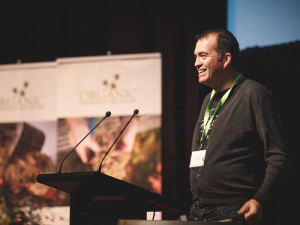The British blogger visited New Zealand to speak at the country’s second Organic and Biodynamic Winegrowing Conference in Marlborough in June this year. His message was emphatic.
“You will maintain an edge in international markets by sticking to a simple clear marketing message going forward in the same way as you have done in the past with Sauvignon Blanc from Marlborough. It’s consistent, reliable and there are no nasty surprises.
“The same type of clear message needs to be communicated when you are talking about your organic and biodynamic wines. The worst message of all is that we do lots of things really well. It’s far better to communicate that we do one thing really well.”
Goode drew on the analogy of his own circuitous route into wine writing. He came to wine writing via a career in book editing, a PhD in plant biology and a passion for wine, which led him to publish wineanorak.com, prior to the success of Facebook in 2008. The timing was fortuitous because there was little competition when he began blogging and, he admits, things have changed dramatically since then, in terms of communication and competition for a share of that voice. But, like New Zealand wine, his message has remained straightforward.
“The reasons for New Zealand’s success internationally so far is that you’ve always had a simple, clear marketing message: Sauvignon Blanc from Marlborough and, now, Pinot Noir from Central Otago. So it’s two clear messages. Because of this consistency, people around the world have come to trust New Zealand as a brand. New Zealand wines taste of vivid flavours from a vivid country.”
He likens New Zealand to Spain with its clear wine message.
“Tempranillo and Albarino are two wines that are easy to appreciate, easy to pronounce and easy to understand. Both resonate well in the United Kingdom.
“I would say to anyone doing anything: just do one thing well and let people know what you stand for. I certainly translate this to my own career – there are loads of wine writers out there, so why would somebody hire you? Because you stand for one thing and do that one thing really well.”
Threats to NZ wine
Loss of brand equity, low alcohol wines and lack of risk taking are all potential threats to New Zealand’s global wine success, suggests Goode.
One of these threats for New Zealand is the potential loss of brand equity, due to a proliferation of private label mass brands as growing numbers of supermarkets create their own labels.
This strips profitability from other brands, so that wine becomes all about price. It also makes organic wine production extremely difficult, due to the high cost involved.
“I think this is dangerous because it forces people into corners by making things continuously cheaper. This certainly comes into play in the vineyard and particularly where organics are concerned, which can cost more.”
Experimentation important
For any country with a successful wine industry, part of the success is based on big companies performing well enough to allow them to invest in creating interesting wines that are good value for money.
“They pump out big quantities of wine but if they do well, then they buy themselves a strong quality reputation and the ability to put time and money into new innovations, such as organic and biodynamic wines.”
Low alcohol, low quality
“Low alcohol wines are a real danger – it’s a trend but the wines are terrible.
“It’s a nonsense. They taste terrible,” says Goode.
“I love wine and I really care about wine but when I taste these wines, I get a bit depressed. I just think wine is wine - it’s not just a beverage. It’s different.”
With only one chance a year to make wine, he suggests allowing it to be what it naturally is rather than denuding it of alcohol to fit a marketing proposition.
He added, apologetically, that: “These are just my thoughts and you can decide whether you want to take them on board.”
Take more risks
The strongest way to get people excited about wine is to take risks. “Often you need a crisis to break free of being in the position where you’re doing okay but not being the exception. I would say for New Zealand, the real thing to do is to take more risks.”
Goode had been strongly impressed by boundary breaking winemaking in South Africa, a country where many winemakers were experimenting.
“For many people winemaking isn’t just a job. It’s something they believe in.
“It’s like a calling, a vocation where they feel they owe it to a patch of land – an amazing patch of land – to create a sensible and intelligible interpretation of that place in the glass. I have seen a lot of that in South Africa.
“There’s plenty of interesting things going on in this country, but I would love to see more interesting wines from New Zealand that wine geeks would take to parties and dinners and say ‘wow, this is really amazing and different’.
“I would love to see New Zealand make more wines that make wine geeks go weak at the knees.”
Goode suggests that the most exciting aspect to wine is not the grape variety, but the place in which it is grown.
“The varietal is boring really, I think.
“What’s exciting is place and the interpretation of that, using the variety to express what that place is all about.”










